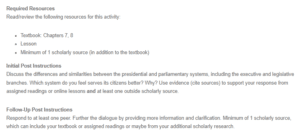Discussion – Presidential and Parliamentary Systems
Differences and Similarities Between the Presidential and Parliamentary Systems
In the presidential system, the president is the CEO and is elected directly by the people of the nation. The executive branch is separate from the legislative branch, which is the arm of the government. In the parliamentary system, the executive is held responsible by the legislature. The presidential system has the judiciary, executive, and legislature operating separately, and all laws are enforced by the head of the government, who is the president. The presidential system rejects the supremacy of the legislature and is designed for nations that are a republic as opposed to a monarchy. Elections in a presidential system are also held more frequently, with the legislature elected every two years while the president is elected every 4 or 5 years.
The parliamentary system was developed in the UK, with other countries adopting the same across the globe. The executive derives its legitimacy from its ability to gain the confidence of the legislature. The executive branch is accountable to the legislature for its actions. The government head is separate from the state head (Financial Times, 2017). Countries with parliamentary systems can either be parliamentary republics or constitutional monarchies. In monarchies, the state head is the monarch, while the government head is the parliament.
Which System Do You Feel Serves Its Citizen Better? Why?
In the formulation of the constitution, the founders envisioned a powerful Congress as it most represents the will of the people. However, presidential powers have increased over the years (Cobb, 2020). I believe the parliamentary system serves its people better because the executive in the parliament is part of the legislature, and most often, the majority party has the stronghold. This makes it easier for policies and laws to be passed and even implemented sooner. There is more coordination in the parliamentary system than in the presidential as the government organs are separate. In the presidential system, power is concentrated in the president, who can override the House of Representatives and Senate will by simply signing executive orders. An example is when the former US president signed an executive order that saw Mexican children separated from their families. The president also has the power to choose the cabinet, while in the parliamentary system, the ruling party is not all-powerful. The parliamentary system has many institutions that keep it in check, and the government can be forced to resign by passing a vote of no confidence (Szilagyi, 2009).
References
Cobb, W. W. (2020). Political science today. SAGE.
Financial Times. [Financial Times] (2017, May 25). The UK election explained [Video]. https://www.youtube.com/watch?v=KgLNdnQoElo
Szilagyi, I. M. (2009). Presidential versus parliamentary systems. AARMS, 8(2), 307-314.
ORDER A PLAGIARISM-FREE PAPER HERE
We’ll write everything from scratch
Question

Presidential and Parliamentary Systems
Required Resources
Read/review the following resources for this activity:
- Textbook: Chapters 7, 8
- Lesson
- Minimum of 1 scholarly source (in addition to the textbook)
Initial Post Instructions
Discuss the differences and similarities between the presidential and parliamentary systems, including the executive and legislative branches. Which system do you feel serves its citizens better? Why? Use evidence (cite sources) to support your response from assigned readings or online lessons and at least one outside scholarly source.
Follow-Up Post Instructions
Respond to at least one peer. Further the dialogue by providing more information and clarification. Minimum of 1 scholarly source, which can include your textbook or assigned readings or maybe from your additional scholarly research.

